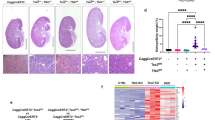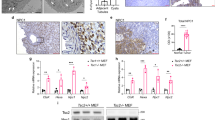Abstract
The protein complex of tuberous sclerosis complex (TSC)1 and TSC2 tumor suppressors is a key negative regulator of mammalian target of rapamycin (mTOR). Hyperactive mTOR signaling due to the loss-of-function of mutations in either TSC1 or TSC2 gene causes TSC, an autosomal dominant disorder featured with benign tumors in multiple organs. As the ubiquitous second messenger calcium (Ca2+) regulates various cellular processes involved in tumorigenesis, we explored the potential role of mTOR in modulation of cellular Ca2+ homeostasis, and in turn the effect of Ca2+ signaling in TSC-related tumor development. We found that loss of Tsc2 potentiated store-operated Ca2+ entry (SOCE) in an mTOR complex 1 (mTORC1)-dependent way. The endoplasmic reticulum Ca2+ sensor, stromal interaction molecule 1 (STIM1), was upregulated in Tsc2-deficient cells, and was suppressed by mTORC1 inhibitor rapamycin. In addition, SOCE repressed AKT1 phosphorylation. Blocking SOCE either by depleting STIM1 or ectopically expressing dominant-negative Orai1 accelerated TSC-related tumor development, likely because of restored AKT1 activity and enhanced tumor angiogenesis. Our data, therefore, suggest that mTORC1 enhancement of store-operated Ca2+ signaling hinders TSC-related tumor growth through suppression of AKT1 signaling. The augmented SOCE by hyperactive mTORC1-STIM1 cascade may contribute to the benign nature of TSC-related tumors. Application of SOCE agonists could thus be a contraindication for TSC patients. In contrast, SOCE agonists should attenuate mTOR inhibitors-mediated AKT reactivation and consequently potentiate their efficacy in the treatment of the patients with TSC.
This is a preview of subscription content, access via your institution
Access options
Subscribe to this journal
Receive 50 print issues and online access
$259.00 per year
only $5.18 per issue
Buy this article
- Purchase on Springer Link
- Instant access to full article PDF
Prices may be subject to local taxes which are calculated during checkout








Similar content being viewed by others
References
Crino PB, Nathanson KL, Henske EP . The tuberous sclerosis complex. N Engl J Med 2006; 355: 1345–1356.
Tee AR, Manning BD, Roux PP, Cantley LC, Blenis J . Tuberous sclerosis complex gene products, Tuberin and Hamartin, control mTOR signaling by acting as a GTPase-activating protein complex toward Rheb. Curr Biol 2003; 13: 1259–1268.
Alessi DR, Pearce LR, Garcia-Martinez JM . New insights into mTOR signaling: mTORC2 and beyond. Sci Signal 2009; 2: pe27.
Laplante M, Sabatini DM . mTOR signaling in growth control and disease. Cell 2012; 149: 274–293.
Gough NR . Focus issue: TOR signaling, a tale of two complexes. Sci Signal 2012; 5: eg4.
Yecies JL, Manning BD . Transcriptional control of cellular metabolism by mTOR signaling. Cancer Res 2011; 71: 2815–2820.
Kim J, Kundu M, Viollet B, Guan KL . AMPK and mTOR regulate autophagy through direct phosphorylation of Ulk1. Nat Cell Biol 2011; 13: 132–141.
Roczniak-Ferguson A, Petit CS, Froehlich F, Qian S, Ky J, Angarola B et al. The transcription factor TFEB links mTORC1 signaling to transcriptional control of lysosome homeostasis. Sci Signal 2012; 5: ra42.
Hay N, Sonenberg N . Upstream and downstream of mTOR. Genes Dev 2004; 18: 1926–1945.
Yang Q, Guan K-L . Expanding mTOR signaling. Cell Res 2007; 17: 666–681.
Davies DM, de Vries PJ, Johnson SR, McCartney DL, Cox JA, Serra AL et al. Sirolimus therapy for angiomyolipoma in tuberous sclerosis and sporadic lymphangioleiomyomatosis: a phase 2 trial. Clin Cancer Res 2011; 17: 4071–4081.
Bissler JJ, McCormack FX, Young LR, Elwing JM, Chuck G, Leonard JM et al. Sirolimus for angiomyolipoma in tuberous sclerosis complex or lymphangioleiomyomatosis. N Engl J Med 2008; 358: 140–151.
Choo AY, Blenis J . Not all substrates are treated equally: implications for mTOR, rapamycin-resistance and cancer therapy. Cell Cycle 2009; 8: 567–572.
Zhang H, Bajraszewski N, Wu E, Wang H, Moseman AP, Dabora SL et al. PDGFRs are critical for PI3K/Akt activation and negatively regulated by mTOR. J Clin Invest 2007; 117: 730–738.
Shah OJ, Wang Z, Hunter T . Inappropriate activation of the TSC/Rheb/mTOR/S6K cassette induces IRS1/2 depletion, insulin resistance, and cell survival deficiencies. Curr Biol 2004; 14: 1650–1656.
Hsu PP, Kang SA, Rameseder J, Zhang Y, Ottina KA, Lim D et al. The mTOR-regulated phosphoproteome reveals a mechanism of mTORC1-mediated inhibition of growth factor signaling. Science 2011; 332: 1317–1322.
Yu Y, Yoon SO, Poulogiannis G, Yang Q, Ma XM, Villen J et al. Phosphoproteomic analysis identifies Grb10 as an mTORC1 substrate that negatively regulates insulin signaling. Science 2011; 332: 1322–1326.
Harrington LS, Findlay GM, Lamb RF . Restraining PI3K: mTOR signalling goes back to the membrane. Trends Biochem Sci 2005; 30: 35–42.
Clapham DE . Calcium signaling. Cell 2007; 131: 1047–1058.
Parekh AB, Putney JW . Store-operated calcium channels. Physiol Rev 2005; 85: 757–810.
Lewis RS . The molecular choreography of a store-operated calcium channel. Nature 2007; 446: 284–287.
Derler I, Madl J, Schutz G, Romanin C . Structure, regulation and biophysics of I(CRAC), STIM/Orai1. Adv Exp Med Biol 2012; 740: 383–410.
Engh A, Somasundaram A, Prakriya M . Permeation and gating mechanisms in store-operated CRAC channels. Front Biosci 2012; 17: 1613–1626.
Feske S, Picard C, Fischer A . Immunodeficiency due to mutations in ORAI1 and STIM1. Clin Immunol 2010; 135: 169–182.
Monteith GR, McAndrew D, Faddy HM, Roberts-Thomson SJ . Calcium and cancer: targeting Ca2+ transport. Nat Rev Cancer 2007; 7: 519–530.
Roderick HL, Cook SJ . Ca2+ signalling checkpoints in cancer: remodelling Ca2+ for cancer cell proliferation and survival. Nat Rev Cancer 2008; 8: 361–375.
Feske S . CRAC channelopathies. Pflugers Arch 2010; 460: 417–435.
Yang S, Zhang JJ, Orai1 Huang XY . and STIM1 are critical for breast tumor cell migration and metastasis. Cancer Cell 2009; 15: 124–134.
Feng M, Grice DM, Faddy HM, Nguyen N, Leitch S, Wang Y et al. Store-independent activation of orai1 by SPCA2 in mammary tumors. Cell 2010; 143: 84–98.
El Boustany C, Bidaux G, Enfissi A, Delcourt P, Prevarskaya N, Capiod T . Capacitative calcium entry and transient receptor potential canonical 6 expression control human hepatoma cell proliferation. Hepatology 2008; 47: 2068–2077.
Chen YF, Chiu WT, Chen YT, Lin PY, Huang HJ, Chou CY et al. Calcium store sensor stromal-interaction molecule 1-dependent signaling plays an important role in cervical cancer growth, migration, and angiogenesis. Proc Natl Acad Sci USA 2011; 108: 15225–15230.
Zhang H, Cicchetti G, Onda H, Koon HB, Asrican K, Bajraszewski N et al. Loss of Tsc1/Tsc2 activates mTOR and disrupts PI3K-Akt signaling through downregulation of PDGFR. J Clin Invest 2003; 112: 1223–1233.
El-Hashemite N, Zhang H, Walker V, Hoffmeister KM, Kwiatkowski DJ . Perturbed IFN-gamma-Jak-signal transducers and activators of transcription signaling in tuberous sclerosis mouse models: synergistic effects of rapamycin-IFN-gamma treatment. Cancer Res 2004; 64: 3436–3443.
Pollizzi K, Malinowska-Kolodziej I, Doughty C, Betz C, Ma J, Goto J et al. A hypomorphic allele of Tsc2 highlights the role of TSC1/TSC2 in signaling to AKT and models mild human TSC2 alleles. Hum Mol Genet 2009; 18: 2378–2387.
Lee L, Sudentas P, Donohue B, Asrican K, Worku A, Walker V et al. Efficacy of a rapamycin analog (CCI-779) and IFN-gamma in tuberous sclerosis mouse models. Genes Chromosomes Cancer 2005; 42: 213–227.
Vig M, Beck A, Billingsley JM, Lis A, Parvez S, Peinelt C et al. CRACM1 multimers form the ion-selective pore of the CRAC channel. Curr Biol 2006; 16: 2073–2079.
Huang GN, Zeng W, Kim JY, Yuan JP, Han L, Muallem S et al. STIM1 carboxyl-terminus activates native SOC, Icrac and TRPC1 channels. Nat Cell Biol 2006; 8: 1003–1010.
Roskoski R . Vascular endothelial growth factor (VEGF) signaling in tumor progression. Crit Rev Oncol Hematol 2007; 62: 179–213.
Howe SR, Gottardis MM, Everitt JI, Goldsworthy TL, Wolf DC, Walker C . Rodent model of reproductive tract leiomyomata. Establishment and characterization of tumor-derived cell lines. Am J Pathol 1995; 146: 1568–1579.
Kobayashi T, Hirayama Y, Kobayashi E, Kubo Y, Hino O . A germline insertion in the tuberous sclerosis (Tsc2) gene gives rise to the Eker rat model of dominantly inherited cancer. Nat Genet 1995; 9: 70–74.
Ma J, Meng Y, Kwiatkowski DJ, Chen X, Peng H, Sun Q et al. Mammalian target of rapamycin regulates murine and human cell differentiation through STAT3/p63/Jagged/Notch cascade. J Clin Invest 2010; 120: 103–114.
Guertin DA, Sabatini DM . Defining the role of mTOR in cancer. Cancer Cell 2007; 12: 9–22.
Ogawa A, Firth AL, Smith KA, Maliakal MV, Yuan JX . PDGF enhances store-operated Ca2+ entry by upregulating STIM1/Orai1 via activation of Akt/mTOR in human pulmonary arterial smooth muscle cells. Am J Physiol Cell Physiol 2012; 302: C405–C411.
Sabbioni S, Barbanti-Brodano G, Croce CM, Negrini M . GOK: a gene at 11p15 involved in rhabdomyosarcoma and rhabdoid tumor development. Cancer Res 1997; 57: 4493–4497.
Suyama E, Wadhwa R, Kaur K, Miyagishi M, Kaul SC, Kawasaki H et al. Identification of metastasis-related genes in a mouse model using a library of randomized ribozymes. J Biol Chem 2004; 279: 38083–38086.
Flourakis M, Lehen’kyi V, Beck B, Raphael M, Vandenberghe M, Abeele FV et al. Orai1 contributes to the establishment of an apoptosis-resistant phenotype in prostate cancer cells. Cell Death Dis 2010; 1: e75.
Gilio K, van Kruchten R, Braun A, Berna-Erro A, Feijge MA, Stegner D et al. Roles of platelet STIM1 and Orai1 in glycoprotein VI- and thrombin-dependent procoagulant activity and thrombus formation. J Biol Chem 2010; 285: 23629–23638.
Grosse J, Braun A, Varga-Szabo D, Beyersdorf N, Schneider B, Zeitlmann L et al. An EF hand mutation in Stim1 causes premature platelet activation and bleeding in mice. J Clin Invest 2007; 117: 3540–3550.
El-Hashemite N, Walker V, Zhang H, Kwiatkowski DJ . Loss of Tsc1 or Tsc2 induces vascular endothelial growth factor production through mammalian target of rapamycin. Cancer Res 2003; 63: 5173–5177.
Sun Q, Chen X, Ma J, Peng H, Wang F, Zha X et al. Mammalian target of rapamycin up-regulation of pyruvate kinase isoenzyme type M2 is critical for aerobic glycolysis and tumor growth. Proc Natl Acad Sci USA 2011; 108: 4129–4134.
Acknowledgements
The mouse kidney tumor tissues were kindly provided by David J Kwiatkowski, Brigham and Women’s Hospital. This work was supported by the National Basic Research Program of China 973 Program Grant (2009CB522107 and 2009CB522203), the National Natural Science Foundation of China Grants (30971503 and 81130085), and the Ministry of Education of China 111 Project (B08007).
Author information
Authors and Affiliations
Corresponding authors
Ethics declarations
Competing interests
The authors declare no conflict of interest.
Additional information
Supplementary Information accompanies the paper on the Oncogene website
Supplementary information
Rights and permissions
About this article
Cite this article
Peng, H., Liu, J., Sun, Q. et al. mTORC1 enhancement of STIM1-mediated store-operated Ca2+ entry constrains tuberous sclerosis complex-related tumor development. Oncogene 32, 4702–4711 (2013). https://doi.org/10.1038/onc.2012.481
Received:
Revised:
Accepted:
Published:
Issue Date:
DOI: https://doi.org/10.1038/onc.2012.481
Keywords
This article is cited by
-
CHD1L prevents lipopolysaccharide-induced hepatocellular carcinomar cell death by activating hnRNP A2/B1-nmMYLK axis
Cell Death & Disease (2021)
-
Direct regulation of fibroblast growth factor 23 by energy intake through mTOR
Scientific Reports (2020)
-
Anti-proliferative Effects of Nucleotides on Gastric Cancer via a Novel P2Y6/SOCE/Ca2+/β-catenin Pathway
Scientific Reports (2017)
-
mTOR promotes pituitary tumor development through activation of PTTG1
Oncogene (2017)
-
STIM1 accelerates cell senescence in a remodeled microenvironment but enhances the epithelial-to-mesenchymal transition in prostate cancer
Scientific Reports (2015)



